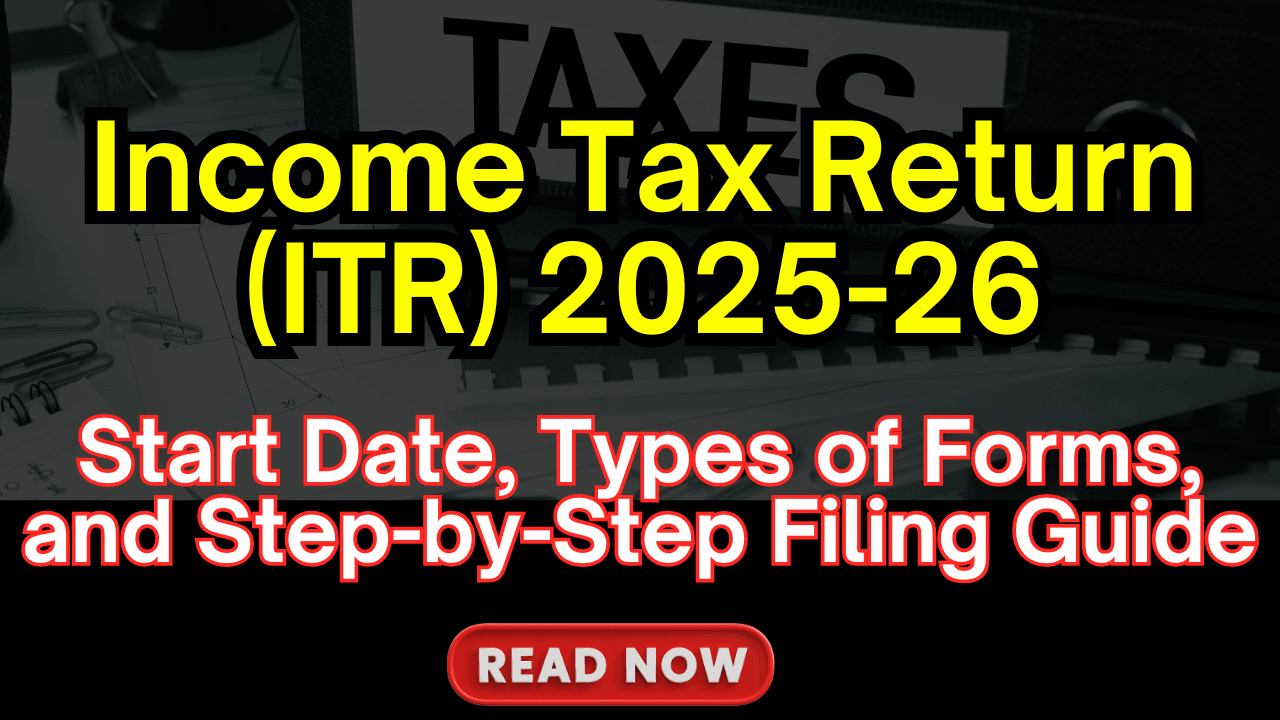Income Tax Return (ITR) 2025-26
Income Tax Return (ITR) 2025-26 Filing your Income Tax Return (ITR) is a crucial financial responsibility that ensures compliance with tax laws and provides numerous benefits such as easier loan approvals, visa processing, and smooth financial transactions. Income Tax Return (ITR) 2025-26 With the financial year 2024-25 nearing its end, taxpayers must prepare to file their ITR for the Assessment Year (AY) 2025-26. Here’s everything you need to know about ITR filing, types of forms, deadlines, and the step-by-step filing process.
ITR Filing Start Date and Important Deadlines
The filing of Income Tax Returns (ITR) for AY 2025-26 will begin on April 1, 2025. Here are the key deadlines to remember:
- Income Tax Return (ITR) 2025-26 For Individuals and Firms (Non-Audit Cases): July 31, 2025
- For Businesses Requiring Audit: October 15, 2025
- For Businesses Requiring Transfer Pricing Report: November 30, 2025
Filing your ITR before these dates is crucial to avoid penalties, interest, or loss of tax benefits.
Types of ITR Forms – Which One Should You Choose?
Choosing the correct ITR form is essential for accurate filing. Below are the details of various ITR forms and their applicability:
- ITR-1 (Sahaj) – For Small Taxpayers
Who can file ITR-1?
- Resident individuals with total income up to Rs 50 lakh
- Income from salary, one house property, and other sources like interest
Who cannot file ITR-1?
- Individuals with capital gains income
- Individuals with foreign assets
- Individuals earning from business or profession
- ITR-2 – For High-Income Individuals and Capital Gains
Who can file ITR-2?
- Individuals with income above Rs 50 lakh
- Income from salary, more than one property, capital gains, foreign assets, or agricultural income exceeding Rs 5,000
- ITR-3 – For Business and Professionals
Who can file ITR-3?
- Income Tax Return (ITR) 2025-26 Individuals earning from business or profession (e.g., doctors, lawyers, freelancers)
- ITR-4 (Sugam) – For Small Business Owners under Presumptive Taxation
Who can file ITR-4?
- Individuals and HUFs with income up to Rs 50 lakh
- Eligible for presumptive taxation (e.g., shopkeepers, cab drivers, electricians)
Who cannot file ITR-4?
- Individuals with foreign assets
- Income under any special exemption section
- ITR-5 – For Partnership Firms and Trusts
- Used by Partnership firms, LLPs, Trusts, Societies, etc.
- ITR-6 – For Companies
- Used by Companies (except those claiming exemption under Section 11 for charitable/religious purposes)
- ITR-7 – For Charitable Trusts, Political Parties, and Institutions
- Used by Religious institutions, Political parties, Research institutes, etc.
https://www.incometax.gov.in/iec/foportal/
Step-by-Step Guide to File ITR Online
Filing your ITR online is now easier than ever. Follow these simple steps for a smooth process:
Step 1: Log in to the e-Filing Portal
- Visit the official Income Tax e-Filing portal: https://www.incometax.gov.in
- Login using your PAN/Aadhaar and password
Step 2: Select ‘File Income Tax Return’
- Go to the ‘e-File’ tab and choose ‘File Income Tax Return’
- Select the Assessment Year 2025-26
Step 3: Choose the Correct ITR Form
- Select the correct ITR form based on your income source
- The portal may suggest the appropriate form automatically
Step 4: Fill in the Required Details
- Enter your personal details, income details, tax deductions, and exemptions
- Cross-check auto-filled data from Form 26AS, AIS, and TIS for accuracy
Step 5: Verify Tax Calculation
- The system will automatically calculate your tax liability or refund
- Ensure all details match your records to avoid errors
Step 6: Submit and Verify Your ITR
- After filling in all details, submit your ITR
- Complete the e-verification using:
- Aadhaar OTP
- Net banking
- Digital signature
Step 7: Download ITR-V (Acknowledgment Form)
- Download the ITR-V form and save it for future reference
Why Timely ITR Filing is Important
Filing your ITR on time ensures:
- Income Tax Return (ITR) 2025-26 Avoidance of late fees and penalties
- Eligibility to carry forward losses to offset future income
- Smooth processing of tax refunds
- Improved financial credibility for loans, credit cards, and visa applications
Common Mistakes to Avoid While Filing ITR
- Choosing the wrong ITR form
- Entering incorrect bank details, delaying refunds
- Income Tax Return (ITR) 2025-26 Forgetting to e-verify your ITR after submission
- Overlooking the inclusion of exempt income like dividends or agricultural income
Conclusion
Income Tax Return (ITR) 2025-26 Filing your ITR is not just a legal responsibility; it plays a vital role in your financial planning. With the Income Tax Department streamlining the e-Filing process, filing your returns accurately and on time has become easier than ever. Start preparing your documents early to avoid last-minute stress and ensure a smooth filing experience.
✅ Stay informed, file on time, and manage your taxes effectively for a secure financial future.
For More Information :https://taxgyany.com/

